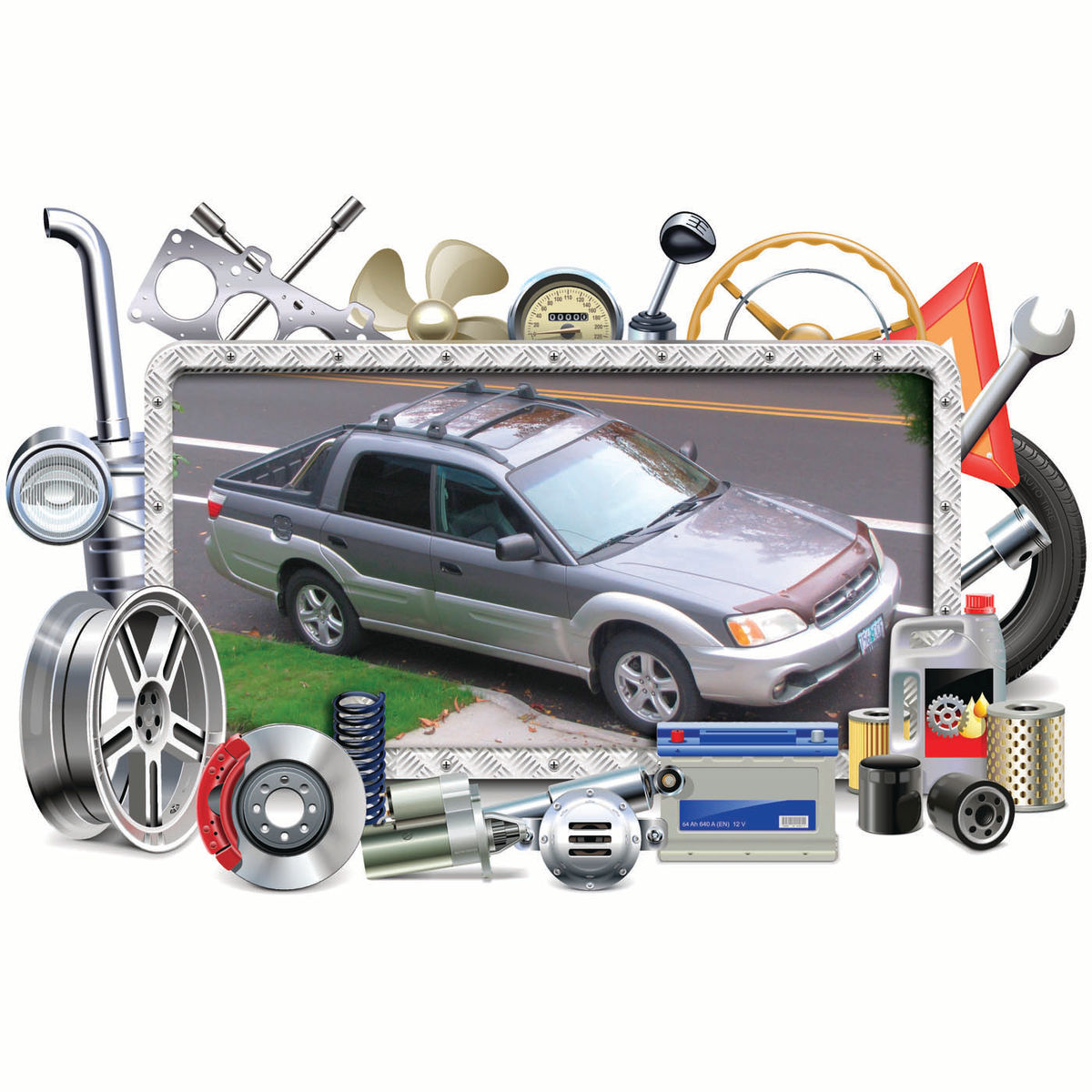CELEBRATING 30 YEARS My Very Useful Toy
He Wanted an Uncommon Vehicle That Could Be Used as a Driver & Hauler. So He Did Some Research and Came Upon…a 2005 Subaru Baja.
Editor’s note: Auto Restorer urges readers to drive and enjoy their favorite rides whether the vehicles are vintage or only slightly vintage. This reader has definitely followed that approach with his 15-year-old Subaru.
Over the years that I have read and enjoyed Auto Restorer I have noticed many requests from the editor for stories about working on and driving newer “vintage” vehicles. So here I go with my personal experience:
Several years ago my wife agreed that I could get a “toy” car. As always, there were considerations and details.
In the Model Railroading community, John Armstrong is remembered for doing model railroad layouts for hire. When he started on a new project he had the client fill out a “Givens and Druthers” list. The “Givens” were things that couldn’t be changed, like the room size and location, and things the client felt he had to have. The “Druthers” were things to include if possible. I figured that I had to make much the same approach.
While researching appropriate vehicles, I realized that I wanted a multipurpose vehicle…one that could haul small amounts of “stuff” and 4x8 sheet goods. It also had to have a unique appearance so that I could take it to neighborhood car shows. And, finally, parts should be readily available.
Living in a metropolitan area also means, in my case, that any vehicle manufactured after 1974 has to pass a smog evaluation at every license renewal.
Vehicles That Were Considered
So I made up a short list of neat vehicles. These are neat to me and ones that I think are interesting. So in no particular order here they are:
1. Chevrolet El Camino and the GMC Sprint and Caballero. 2. Ford Ranchero. 3. Dodge Rampage. 4. VW Rabbit Pickup. 5. VW Dropside Pickup. 6. International Light Trucks 7. Studebaker Pickups. 8. AMC Hornet Wagon; later the AMC Eagle Wagon. 9. Ford Taurus and Mercury Sable Wagons in the 1996 through 1999 model years. 10. Subaru Baja. 11. Subaru BRAT. 12. Ford Aerostar (Short version). 13. Chevrolet Camaro (2nd generation)
Some Common Themes Among the Candidates
Thinking about all the various vehicles that I liked, I realized that there was a bit of a theme holding the selections together. I was seeking reasonable simplicity, good design and good engineering in each of three groupings: One group is the car pickup and light duty pickup, second is the station wagons and vans, and third, there’s a single lonely coupe.
The lonely coupe is the secondgeneration Chevrolet Camaro; early 1970s edition with the sleek lines. It looks good and they are starting to catch on with car people.
The next group is the wagons and vans. Well, really just one van, the short version of the Ford Aerostar. The station wagons are the long-running AMC Hornet and Eagle wagons (sort of a shrunken Nomad), and the 1996 to 1999 Ford Taurus and Mercury Sable wagons (the spaceship ones).
The pickups were the largest group with the greatest time span. The International KB came out in 1949, I think, and International lasted into the 1970s with several redesigns, along with the timeless Studebaker. Even the Studebakers with the Lark-based cab from the 1960s are interesting. And then there are the Dodges from the middle 1950s.
But the car-based pickups are the ones that seemed to most interest me. Almost all the El Caminos and Rancheros are in someone’s garage being worked on. The Volkswagen Rabbit Pickup and Dodge Rampage are economical and still useful. And the Volkswagen Transporter is just plain different, as are the Subaru BRAT and Baja. The Baja is the only one of the pickups that can carry four people, inside. The BRAT can carry four…but two of them have to sit in the bed.
Determining the Vehicle’s Potential Use Is Important
Besides choosing a vehicle, I thought it would be helpful to figure out what I wanted to do with the rig. I wanted a vehicle that was unique in appearance and had some possibilities for “Changing.” Every once in a while I need to haul some plywood, bricks, bags of sand and the like a couple of miles. Really, that’s not worth a full-size pickup. My need is more for a motorized wheelbarrow able to move at speed. Plus, if it were to be used as a “go visiting” rig for some reason, then a wife and two small dogs are going along also.
For comparison purposes, the other vehicles I currently have on hand in my stable are a Mazda Miata and a Hyundai Elantra Touring (a Hyundai I30 outside of the United States, which is basically a front-wheel-drive SUV body).
Take Stock of Resources and Work Space
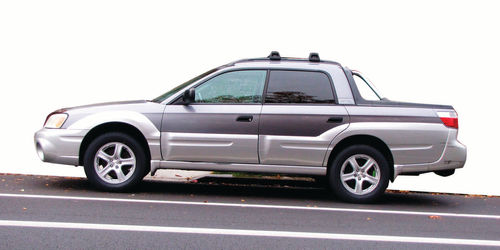
In terms of on-hand resources (besides Auto Restorer, of course) there are the usual online and mail order parts resources; I am lucky enough to have a top-notch interior upholstery shop handy, and there’s a Subaru independent service shop and Subaru dealer within walking distance of the house.
Being in a large metropolitan area also means that there is reasonable access to all sorts of dealers and shops. Also, there are several salvage yards around, both “You pull it” and “They pull it” types, with several specializing in certain brands.
Unfortunately, my home has no garage or outside storage area, so any vehicle work I undertake must be done with the vehicle in the street. The ranch is 60 feet by 62 feet with a house in the middle. I have a driveway, but even the Miata is too large for it. As a consequence, all of my vehicles live on the roadway.
Narrowing the List to a Baja
I finally decided that a Subaru Baja was the vehicle that best met my desires, perceived needs and budget. To be a good show car, a yellow upper body over the silver plastic cladding would have been preferred, but this color was only available in the 2003 model year.
Keeping a close eye on Craigslist I found that there were several Bajas for sale in my area, both on car lots and privately. Most of them were 2003 models which is understandable as that was the first year of sale. With only 30,000 production units spread over four model years and sold in four countries, I was surprised to find so many locally. But then the greater Portland Metropolitan area has long been a good Subaru market.
All Subaru Bajas were made in Lafayette, Indiana, and sold in the United States, Canada, South Africa and Chile. At the time of manufacture, the Baja actually was a General Motors product as the General had a controlling interest in the brand.
The model was based on the STX concept car shown in 2000 and first produced in 2002 as a 2003 model and last produced in 2006. Several modifications were made during that production run, chiefly the inclusion of the turbo engine and an additional 2 inches of ground clearance. In reality, the Baja is just a 2000-2004 Legacy Outback with modifications behind the front seats, which means that most repair and modification parts are readily available.
Finding My Baja
I found a 2005 model with 163,000 miles that was an estate sale. This was a one-owner vehicle that had been purchased, kept and serviced locally. The late owner’s son related that his father had used the Baja as his personal vehicle, lived on a small farm, and wintered in Arizona. Several round trips from Portland, Oregon, to Arizona accounted for about half of that mileage. The purchase included a full set of replacement brake pads.
The owner had kept some purchase records which indicated that the vehicle had been purchased at the end of the 2005 model year with several dealer add-ons. The major add-ons were the Bed Extender, Trailer Hitch, Front Hood Air Deflector and Rubber Floor mats. The service records showed that the oil changes had been regular (he had purchased the Life Time Dealer Oil Change option for $99), and that the expected head gasket repair had been done 14 months and 14,000 miles previously.
The Subaru EJ251 4-cylinder engine is prone to head gasket leaks between 50,000 and 150,000 miles (even when dealer rebuilt) due to the combination of the internal design and a very basic head gasket material. The head gaskets are a composite design with a constant exposure to engine oil and coolant. The rebuild really needs the very best aftermarket gaskets to be truly successful.
While on the subject of chronic problems, the other major item is the right front axle. There are 2 constant velocity joints in each axle. The right front inboard one is immediately under the exhaust manifold and the rubber boot gets baked and then splits. This admits all sorts of grime and nasty things into the joint with the expected results of joint destruction. The boots on this vehicle passed inspection.
The inspection drive showed that while there were some cosmetic issues, the vehicle’s “bones” were sound. The post-purchase inspection I had done at my local Subaru specialist (conveniently located just three blocks from my home) showed that most items needed fell into the “deferred maintenance” category versus “major repairs,” although I must admit I did find that they missed a “major repair.” That repair was the need for an automatic transmission rebuild, although after 163,000 miles I probably should have expected that.

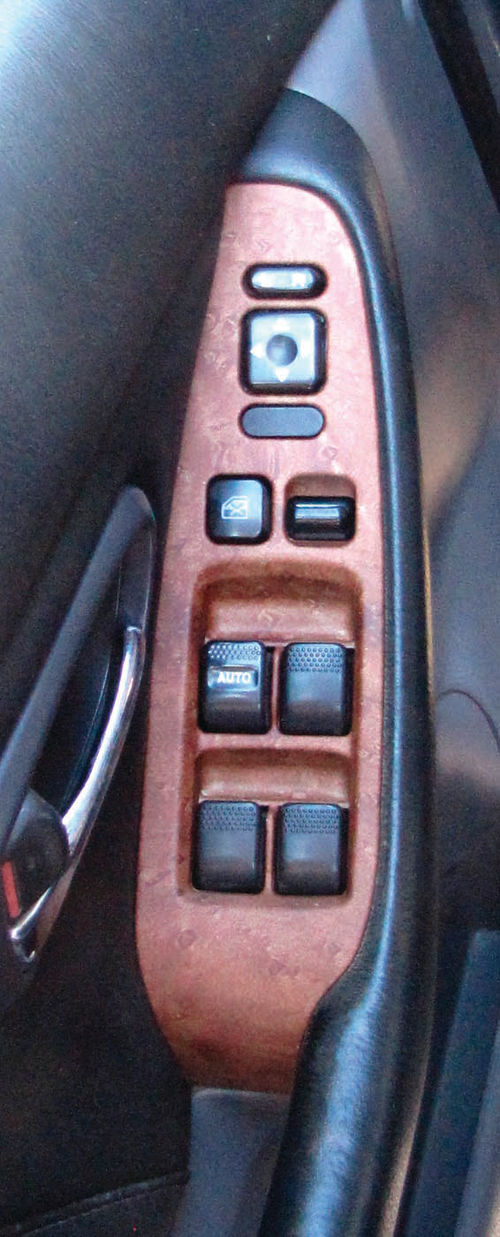
The repairs and fixes done so far have involved tires, fluids and normal used-car stuff. Upgrades have been to make the vehicle more livable. The steering wheel has been replaced with a Subaru OEM leather-wrapped one that I took out of a scrap yard car.
The interior accent panels were silverpainted plastic that had the silver worn through in places and scratched. Thanks to an article in Auto Restorer I had some idea that hydrographic application would work. Hydrographics is a well-established process that applies any of a wide variety of decorations to flat or curved pieces. A film with the decoration is floated on a pool of water while the piece being decorated is raised up through the film. The film dries and becomes permanent. A local firm, Blazin Hydrographics, did a fine job which improved the aesthetics.
The parts that were hydrographic treated were the window switch panels in each door, the trim piece under the dash instruments to the left of the steering column, the radio/HVAC controls surround to the right of the steering column and the gear shift lever surround. Since I did a share of the preparation work and was willing to work with the firm’s schedule the cost was competitive with aftermarket pieces which were, frankly, not as attractive.
I replaced the single DIN-sized radio with a 2006 Subaru Forester double DIN sized radio/CD changer that I got off eBay. It was a perfect fit with the correct color match for the installation. An extra benefit was the NOAA Weather Radio tuner that was in the new radio.
Five of the six speakers were blown. The one that worked was a tweeter. Replacing them involved making custom mounting rings to be able to install the new speakers. I was able to locate and install an accessory amplified sub-woofer that Subaru offered, probably as a dealerinstalled option. The result is that this is probably the best-sounding setup in any of my vehicles.
Another major interior item that needed attention was the driver’s seat as the outside seat bolsters were broken down and the vinyl was worn through. After using the vehicle for two years, I suspect that the bolster damage is due to the height of the seats above the ground. On leaving the vehicle your feet don’t quite reach the ground unless you sit on the bolster. A short-term fix has been the installation of seats from a salvage yard Subaru Legacy.
Seeking a Long-Term Plan for the Seats
An article in the Mechanic on Duty section of the March 2018 Auto Restorer showed how to restore a 1966 Mustang seat. And YouTube has several good posts that show the general approach to do a rebuild with new premade seat covers.
I found that the Subaru seats were designed to be assembled and disassembled in only one way. The hardest part of the process was installing hog ring clips that connect the seat cover to the wires that are embedded in the seat pad. This is what gives the seat its shape and holds the cover in place After tearing the seats down, cleaning the fabric, obtaining a new seat cushion pad, cleaning and painting the metal parts, I have come to the conclusion that the professionals earn their fees for rebuilding seats. So, the jury is still out on how to deal with the original seats. It is possible for the vinyl to be replaced or for about the same cost, a complete leather interior made and installed or maybe a custom fabric can be found that will match with the original rear seat covers.
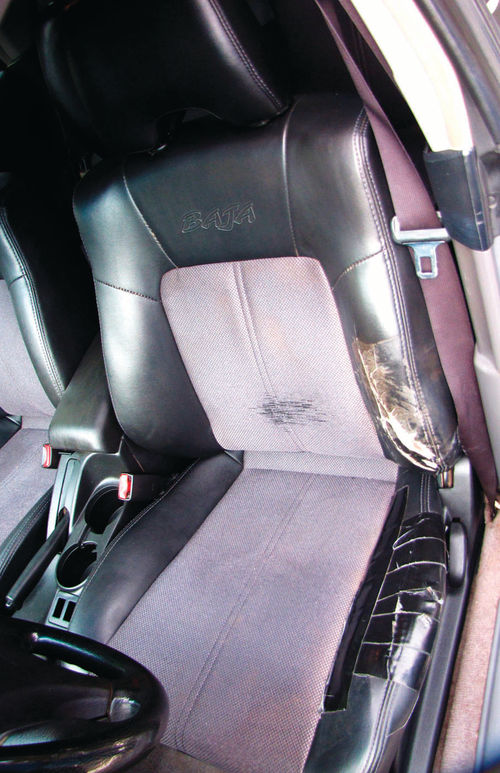
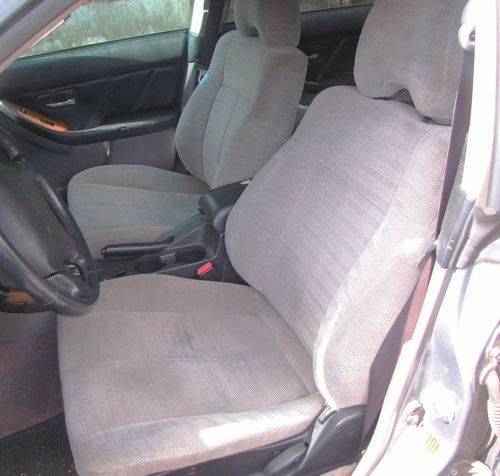
Exterior Cosmetic Work
I have done some minor exterior paint and plastic bumper cover repairs. Microfinish LLC in New Orleans, Louisiana, provided an exact paint match in aerosol cans under the AutomotiveTouchup brand. The paint for both the metal and plastic parts is a perfect match and has stood up well for two years. They also provided paint to cover a faded panel on the Hyundai. This also matched perfectly and has stood up at least as well as the factory paint. NAPA has some plastic epoxy material that is meant for bumper covers which has stood up well. These operations are basically labor intensive repairs, but relatively speaking, are simple.
Plans For the Vehicle
A few words about the budget and future work. At this time about 90% of the “must do” deferred maintenance items have been done. The air conditioner works, barely, so that system needs attention. And there are always the things that any 15-year-old car needs such as strut bushing replacement and the usual “parking lot” dings.
The driver’s door hinges appear to be worn a bit, and the door stop needs replacing. As luck would have it, Auto Restorer ran articles in the October and November 2017 issues by John Armstrong that illustrates how to do that. The only difference is that the article work was done on a 2006 Chevrolet Malibu. But the General Motors touch is apparent in my Baja as the door cards are clones and when I took off the doormounted switch control panel, the same clip fell off that John had mentioned.
Currently the repair and improvement work done is about 80% of the purchase price. When the purchase price and the other costs are combined the budget I had hoped to hold to was busted by 54 dollars. To put it in perspective, it is still well under the purchase price of even the cheaper new vehicles.
My opinion of this vehicle is that is a very good trip and errand vehicle. It is quiet and comfortable with reasonable mileage. The flat engine design is vibration-free. It easily keeps pace with highway traffic…and is unlikely to be hard to locate in a crowded parking lot.

